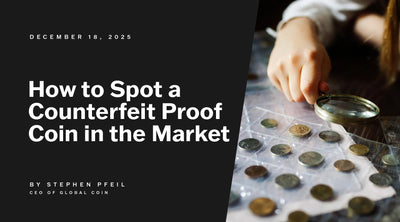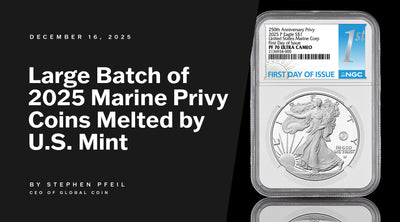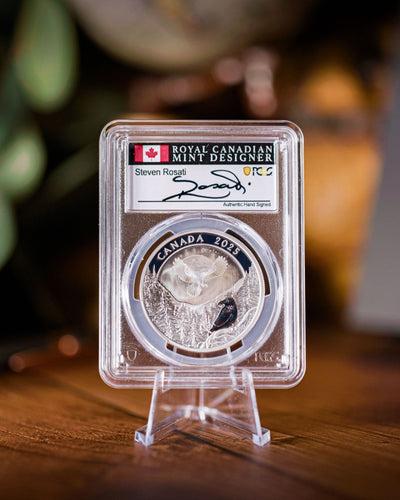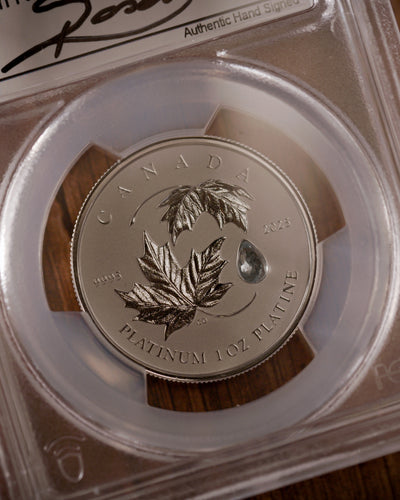Comprehensive Guide to Gold Manipulation: Conspiracy Theory or Market Reality?
Global Coin is a dealer of precious metal coins and does not provide investment, financial, or legal advice. Any information provided in this content, including market commentary and insights, is for informational purposes only and should not be construed as...

Global Coin is a dealer of precious metal coins and does not provide investment, financial, or legal advice. Any information provided in this content, including market commentary and insights, is for informational purposes only and should not be construed as investment advice. Investors should conduct their own due diligence and consult with a qualified financial professional before making any investment decisions. Gold and rare coin investments involve risks, and past performance is not indicative of future results.
Gold Market Manipulation: Conspiracy or Calculated Control?

Global Coin is a dealer of precious metal coins and does not provide investment advice from financial institutions or legal advice. Any information provided in this content, including market commentary and insights, is for informational purposes only and should not be construed as investment advice. Investors should conduct their own due diligence and consult with a qualified financial professional before making any investment decisions. Gold and rare coin investments involve risks, and past performance is not indicative of future results.
In my over two decades navigating the glittering trenches of precious metals—from flipping silver rounds in the early 2000s to advising on multimillion-dollar gold portfolios amid 2008’s crash—gold market manipulation has loomed like a shadow over every trade among market participants. One key factor is the dollar's dominance in the global financial system, where maintaining the US dollar’s reserve currency status can influence efforts to suppress gold prices and reinforce the dollar’s position. Is it tinfoil-hat paranoia or cold, calculated corner-cutting by the big players? With spot gold surging to $3,895 per ounce today—up over 45% year-to-date amid U.S. shutdown fears and Fed cut whispers—it’s a question that hits harder than ever. This refreshed guide draws from my frontline experiences, proven scandals, and fresh 2025 probes to unpack the mechanics, myths, and maneuvers. Whether you’re stacking for the long haul or eyeing quick flips, arm yourself with facts to sidestep the sleight of hand.
Key Points
-
In my dealings, gold market manipulation boils down to big banks and central banks rigging prices unfairly—think spoofing or shorts to prop the dollar.
-
I’ve watched convictions unfold: The 2014 London Fix fines and JP Morgan’s 2023 trader sentencing for 2008-2016 schemes, now echoed in ongoing 2025 class action lawsuit.
-
Paper gold—futures and derivatives—swamps spot via COMEX volumes (COMEX being a major commodity exchange), twisting supply signals and fueling artificial dips I’ve dodged. The futures market plays a key role in price formation and manipulation here.
-
Central banks like the Fed hoard 261 million ounces ($1 trillion market value now), accused of suppression, though proof’s slippery.
-
OTC shadows hide trades—no central ledger means opacity I navigate with volume scans.
-
Spot tricks? My toolkit: Moving averages for reversals, RSI divergences for fakes, volume spikes as red flags.
-
Shield your stack: Diversify beyond gold, clutch physical (my Eagles over ETFs), buy slabbed from vets like Global Coin, think decades not days.
-
Regs like CFTC and LBMA chase spoofers, but OTC gaps persist—vigilance is my edge.
-
Fed’s gold ($1T market vs. $18.9T M1)? Once backed bucks; now, it’s a whisper of fiat fragility.
Gold Manipulation: Executive Summary
Gold market manipulation? It’s when heavyweights—banks, bulls, or bureaucrats—who influence prices orchestrate price puppets, peddling fakes or flooding futures to fleece the field. From my auction pits to dealer desks, I’ve seen it skew safe-havens, shorting shines to suit their sheets. Implications? Distorted price discovery—meaning the process by which market prices are set—dings diversification, as manipulation can undermine the integrity of price discovery, luring latecomers low while insiders load high.
Key Players and Proven Cases

The suspects? Same old suspects in my book: JP Morgan, Deutsche, HSBC, Barclays—major banks with tentacles in trades and a history of gold market manipulation. The 2014 London Gold Fix? A rigged ring of calls cashed fines (£26M total), Barclays busted for benchmark bends. JP’s spoof saga? Their head honcho trader jailed two years in 2023 for 2008-2016 slams—fake orders to floor prices, then feast. Deutsche’s $60M 2016 slap? That was the Deutsche Bank settlement, resulting from a class action lawsuit over silver-gold shenanigans. These class action lawsuits have been instrumental in holding major banks accountable for manipulating prices in the gold market. These institutions have repeatedly sought to manipulate prices, with various schemes and strategies aimed at manipulating prices and rigging prices unfairly.
Central suspects: Fed whispers in the financial markets of dollar defense via dumps—GATA’s gospel, but gossamer evidence. Bullion banks? Their wholesale webs weave woes, derivatives as daggers.
Proving? Tough as forging—intent’s the iceberg tip.
Bullion Banks and Gold Market Instruments
Bullion banks are the power brokers of the gold market, wielding significant market influence that can shape price moves across the globe. Acting as intermediaries, these financial institutions connect buyers and sellers, facilitate massive trades in physical gold, and dominate the world of gold market instruments. Whether it’s futures contracts, options, or gold certificates, these tools are the lifeblood of the modern gold market—used by everyone from institutional investors to hedge funds to manage risk, speculate, or hedge against economic uncertainty.
The Commodity Futures Trading Commission (CFTC) keeps a watchful eye on the trading of these gold market instruments, aiming to prevent price manipulation and uphold market integrity. But with the sheer complexity of the gold market and the involvement of major financial institutions, including bullion banks, detecting and stopping manipulative practices is no easy feat. The London Bullion Market Association (LBMA) and the World Gold Council also play crucial roles, setting standards and promoting transparency among market participants, while central banks—guardians of significant gold reserves—can sway the market through their buying, selling, and gold leasing activities.
The paper gold market, which includes futures contracts and other derivatives traded on commodity exchanges like COMEX, often sees trading volumes that dwarf the actual supply of physical gold. This disconnect between paper and physical gold creates fertile ground for price manipulation, as large players can influence prices by selling large quantities of paper gold, creating artificial supply, or triggering price spikes and dips that don’t reflect natural market forces. Institutional investors, such as pension funds and mutual funds, add to the volatility, their massive trades sometimes moving gold prices in ways that defy normal market behavior.
Market analysts and experts scrutinize trading patterns, economic data, and market developments to spot signs of manipulation or unusual price movements. Regulatory bodies like the Securities and Exchange Commission (SEC) and the CFTC are tasked with enforcing rules and protecting investors, but the global and opaque nature of the gold market—especially the over-the-counter (OTC) trades—means that some activities slip through the cracks.
Recent years have seen major financial institutions, including Deutsche Bank, face legal consequences for their roles in gold price manipulation. These high-profile cases underscore the ongoing risks in the gold and silver markets and the need for continued vigilance, transparency, and accountability among all market participants.
Beyond the banks and the paper gold market, external factors like the US dollar’s strength, shifts in financial benchmarks such as the London Interbank Offered Rate (LIBOR), and broader economic uncertainty all feed into gold price movements. Central banks’ actions, whether accumulating or selling gold reserves, can send ripples through the market, influencing both gold and silver prices and impacting the purchasing power of investors worldwide.
For those looking to protect themselves, owning physical gold remains a time-tested strategy. Physical gold is immune to the counterparty risks and price manipulation that can plague the paper gold market. By staying informed about regulatory actions, market trends, and the activities of major players, investors can better navigate the complexities of the gold market and safeguard their wealth against the unpredictable tides of financial markets.
How the Paper Gold Market Influences Spot Prices
Paper’s the phantom in my trades—COMEX futures, options, ETFs eclipsing earth-mined metal. These instruments are all part of the broader derivative markets and derivatives markets, which play a key role in gold price manipulation by allowing financial institutions to influence prices through practices like strategic short selling and spoofing. Volumes? Over twice yearly output daily, per my scans—spec shorts swamp spots, birthing bogus bids.
Hedgers and hotshots? Futures flood forecasts, 2020’s $80 contango crush my COVID calls. Sentiment spirals: Paper pumps panic, physical lags—feedback frenzy I’ve flipped for fills.
Leverage lurks: Bets balloon beyond bars, birthing bubbles or busts.
Real-Life Cases of Proven Gold Price Manipulation

Proof in the pudding—or penalties:
-
London Gold Fix (2014): FCA’s fury fined fixers for phantom fixes—secret swaps skewed benchmarks.
-
JP Morgan Spoof (2020-2023): $920M mega-fine for mirage orders—sell shadows to sink, buy bargains. Trader’s term? Two years tuned.
-
Deutsche Bank settlement (2016): $60M muzzled for metal meddles—resulting from a class action lawsuit for conspiracy confirmed.
Short sells? Sell high, repurchase low—manipulation’s mask. Tactics like spoofing and short selling are used to sell gold at a lower price, driving prices lower in the market.
The Role of Central Banks in Gold Market Dynamics
Centrals command my caution—34,000 tonnes global grip (17% aboveground), buys/bails bend bars. These central bank holdings represent a significant portion of the world's gold reserves and play a major role in market dynamics. Central banks hold gold as a reserve asset, and their decisions to buy, sell, or lease gold can influence prices and overall market behavior. China’s 2022+ spree? Spot sustainer.
Policy pivots: Rate rips ripple—lows lift gold vs. yields. Accusations? Fed’s dollar darling defense via dumps—GATA’s grudge, but ghosts more than gold.
Legit levers or lurid lies? My ledger: Mostly macro, but monitor moves.
Why Transparency in Gold Trading Remains Elusive

Gold’s gloom? OTC opacity—off-exchange shadows swallow swaps, no ticker tape. No normed notes: Data drags, delayed drops. Unlike stock markets, which operate under strict regulation and centralized reporting systems that enhance transparency and facilitate market manipulation detection, gold trading lacks such oversight and openness.
Paper puzzles: Derivatives dazzle with dark pools, leverage lost in ledgers. Centrals cloak caches; supply sins (conflict chains) compound.
Reforms? Blockchain beckons, but beasts balk—my bet: Baby steps to beams.
Spotting Manipulation: Tools I've Used
Anomalies alert me:
-
Moving Averages: SMA/EMA echoes trends—wild wobbles whisper wrongs.
-
Oscillators (RSI/MACD/CCI): Overbought oddities, divergences defy—spikes sans sense scream spoof.
-
Volume Analysis: Volume voids in vaults? Vapor trades.
-
Pivot Points: Breaks baseless? Brake for bids.
-
Price-Volume Ties: Motion minus mass? Mirage moves.
Combo crafts clarity—my charts catch crooks.
How to Protect Your Investments in a Manipulated Market

My playbook for peril:
-
Diversify: Beyond bullion—stocks, bonds, crypto cocktail crushes crashes.
-
Physical First: Coins/bars beat bytes—my Eagles evade exchange evaporations. Owning physical gold is a proven strategy for maintaining purchasing power, especially in the face of market manipulation and economic uncertainty.
-
Reputable Sources: Slabbed via PCGS, Global Coin guardians—fakes flee.
-
Long Lens: Decades dodge daily dances—history hails holders.
-
Monitor Metrics: Tech tells, news nudges—sell on spoofs.
-
Informed Intel: CFTC cues, market murmurs—my morning ritual.
Tailor to tolerance—timeless trumps tricks.
What Gold Investors Should Know About Regulatory Oversight

Watchdogs wag: CFTC collars COMEX crooks—spoof sweeps, wash watches. SEC snags securities sides.
Global gaze: LBMA's London leash, price protocols; World Gold whispers wisdom.
Gaps gape: OTC outlaws oversight—blockchain bridges beckon, but beasts bide. Fines flow, but finesse flees—my vigilance vaults value.
Comparison of US Central Bank Gold Reserves and Book Value Compared to M1 Expansion and Imputed Values
Fed’s fortress: 261 million ounces, book $11B (statutory $42/oz), market $1 trillion at $3,895 spot.
M1? $18.9T August surge—post-2008/COVID cash cascade.
Ratio? Gold’s 5% sliver of M1—gold standard ghosts, now reserve relic amid floats. Inflation ink? Gold gleams as gauge, manipulation murmurs in mismatches. During periods of market stress, gold reserves can provide critical stability, helping to anchor confidence and support the financial system.
Conclusion and Investment Implications
Gold market manipulation? My verdict: Myth-meets-math, with London lows and JP jabs as jury-proof, central shadows as suspects sans slam-dunks. Paper phantoms phantom prices, tools tease tricks, protections parry punches. Regs reel 'em in raggedly, reserves remind of roots—$1T trove vs. $18.9T tide whispers warnings.
Implications? Invest eyes-wide: Physical pivots prevail, diversify dodges daggers. In 2025's $3,895 surge, vigilance vaults victory—my mantra for metallic mastery.
Separating Fact from Fiction
Gold market manipulation's my perennial puzzle—paranoia vs. playbook? CFTC collars confirm crooks in futures fogs, but not every ebb's engineered. Econ echoes, policy pulses, sentiment swells—manipulation's merely mischief amid multitudes.
Physical? My fortress—immune to ink illusions, paper prone to ploys. Fed fiddles rates, not rigs rings—macro moves, not malarkey. Banks' blemishes? Past penalties, not perpetual plots; institutions invest, not infest.
Stay schooled: News nets, experts edge—fiction flees facts in my forge.
Gold Price Manipulation: Separating Market Forces from Physical Reality
At Global Coin, transparency’s my touchstone—tangible treasures, no tricks. Proven ploys like London’s fix-fumble and JP’s spoof-spree spotlight bankroom blunders, but physical gold? Untouchable bastion. Similar manipulation tactics have also been observed in the silver market, which, due to its unique dynamics and smaller liquidity, is especially vulnerable to such schemes.
Paper pandemonium—futures/ETFs eclipsing earth—echoes excesses, excess eclipsing equity. Physical? Pure possession, counterparty-proof, crisis-crowned. Major players are sometimes accused of suppressing prices through coordinated actions, and other traders have also been implicated in these manipulation schemes.
Centrals and suits sway systems, but slabs stack sovereign—my counsel: Clutch coins, conquer chaos. Global Coin curates exclusives—rare royals, investment irons—your shield in shines.
Related Articles

How to Spot a Counterfeit Proof Coin in the Market
How to Spot a Counterfeit Proof Coin in the Market In the world of numismatics, few things hold ...
Discover More
BREAKING NUMISMATIC NEWS: Large batch of 2025 Marine Privy Coins MELTED by U.S. Mint
BREAKING NUMISMATIC NEWS: Large batch of 2025 Marine Privy Coins MELTED by U.S. Mint A historic ...
Discover More
Tax Implications When You Sell Gold Bullion in Different States
Disclaimer: The following content is for informational purposes only and should not be construed ...
Discover More








1 comment
The discussion around gold manipulation highlights why many investors turn to physical ownership as the ultimate safeguard. At BOLD Precious Metals, we emphasize transparency and real value, helping investors secure tangible gold assets that remain outside the risks of paper-market distortion.
Lisa
Leave a comment
This site is protected by hCaptcha and the hCaptcha Privacy Policy and Terms of Service apply.